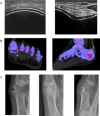2015 Gout Classification Criteria: an American College of Rheumatology/European League Against Rheumatism collaborative initiative
- PMID: 26352873
- PMCID: PMC4566153
- DOI: 10.1002/art.39254
2015 Gout Classification Criteria: an American College of Rheumatology/European League Against Rheumatism collaborative initiative
Erratum in
-
Errata.Arthritis Rheumatol. 2016 Feb;68(2):515. doi: 10.1002/art.39536. Arthritis Rheumatol. 2016. PMID: 26808828 Free PMC article.
Abstract
Objective: Existing criteria for the classification of gout have suboptimal sensitivity and/or specificity, and were developed at a time when advanced imaging was not available. The current effort was undertaken to develop new classification criteria for gout.
Methods: An international group of investigators, supported by the American College of Rheumatology and the European League Against Rheumatism, conducted a systematic review of the literature on advanced imaging of gout, a diagnostic study in which the presence of monosodium urate monohydrate (MSU) crystals in synovial fluid or tophus was the gold standard, a ranking exercise of paper patient cases, and a multicriterion decision analysis exercise. These data formed the basis for developing the classification criteria, which were tested in an independent data set.
Results: The entry criterion for the new classification criteria requires the occurrence of at least 1 episode of peripheral joint or bursal swelling, pain, or tenderness. The presence of MSU crystals in a symptomatic joint/bursa (i.e., synovial fluid) or in a tophus is a sufficient criterion for classification of the subject as having gout, and does not require further scoring. The domains of the new classification criteria include clinical (pattern of joint/bursa involvement, characteristics and time course of symptomatic episodes), laboratory (serum urate, MSU-negative synovial fluid aspirate), and imaging (double-contour sign on ultrasound or urate on dual-energy computed tomography, radiographic gout-related erosion). The sensitivity and specificity of the criteria are high (92% and 89%, respectively).
Conclusion: The new classification criteria, developed using a data-driven and decision analytic approach, have excellent performance characteristics and incorporate current state-of-the-art evidence regarding gout.
© 2015 The Authors. Arthritis & Rheumatology is published by Wiley Periodicals, Inc. on behalf of the American College of Rheumatology.
Figures



References
-
- Zhu Y, Pandya BJ, Choi HK. Prevalence of gout and hyperuricemia in the US general population: the National Health and Nutrition Examination Survey 2007–2008. Arthritis Rheum 2011;63:3136–41. - PubMed
-
- Richette P, Clerson P, Bouee S, Chales G, Doherty M, Flipo RM, et al. Identification of patients with gout: elaboration of a questionnaire for epidemiological studies. Ann Rheum Dis 2014. E‐pub ahead of print. - PubMed
-
- Bardin T, Bouee S, Clerson P, Chales G, Doherty M, Flipo RM, et al. Prevalence of gout in the adult population of France in 2013 [abstract]. Ann Rheum Dis 2014;73 Suppl 2:787–8.
Publication types
MeSH terms
Substances
Grants and funding
LinkOut - more resources
Full Text Sources
Other Literature Sources
Medical

